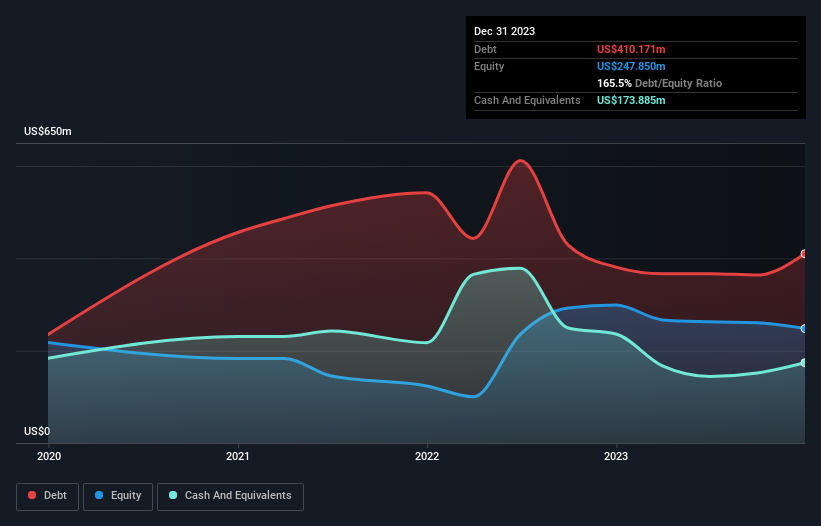Some say volatility, rather than debt, is the best way to think about risk as an investor, but Warren Buffett famously said that 'Volatility is far from synonymous with risk.' So it might be obvious that you need to consider debt, when you think about how risky any given stock is, because too much debt can sink a company. We can see that Gogoro Inc. (NASDAQ:GGR) does use debt in its business. But the more important question is: how much risk is that debt creating?
When Is Debt Dangerous?
Debt and other liabilities become risky for a business when it cannot easily fulfill those obligations, either with free cash flow or by raising capital at an attractive price. If things get really bad, the lenders can take control of the business. While that is not too common, we often do see indebted companies permanently diluting shareholders because lenders force them to raise capital at a distressed price. Of course, the upside of debt is that it often represents cheap capital, especially when it replaces dilution in a company with the ability to reinvest at high rates of return. When we think about a company's use of debt, we first look at cash and debt together.
View our latest analysis for Gogoro
What Is Gogoro's Net Debt?
You can click the graphic below for the historical numbers, but it shows that as of December 2023 Gogoro had US$410.2m of debt, an increase on US$381.2m, over one year. However, it also had US$173.9m in cash, and so its net debt is US$236.3m.

How Strong Is Gogoro's Balance Sheet?
We can see from the most recent balance sheet that Gogoro had liabilities of US$214.1m falling due within a year, and liabilities of US$371.5m due beyond that. Offsetting this, it had US$173.9m in cash and US$17.1m in receivables that were due within 12 months. So it has liabilities totalling US$394.5m more than its cash and near-term receivables, combined.
This is a mountain of leverage relative to its market capitalization of US$454.6m. This suggests shareholders would be heavily diluted if the company needed to shore up its balance sheet in a hurry. When analysing debt levels, the balance sheet is the obvious place to start. But ultimately the future profitability of the business will decide if Gogoro can strengthen its balance sheet over time. So if you're focused on the future you can check out this free report showing analyst profit forecasts.
In the last year Gogoro had a loss before interest and tax, and actually shrunk its revenue by 8.6%, to US$350m. That's not what we would hope to see.
Caveat Emptor
Over the last twelve months Gogoro produced an earnings before interest and tax (EBIT) loss. Indeed, it lost a very considerable US$86m at the EBIT level. Considering that alongside the liabilities mentioned above does not give us much confidence that company should be using so much debt. Quite frankly we think the balance sheet is far from match-fit, although it could be improved with time. However, it doesn't help that it burned through US$57m of cash over the last year. So in short it's a really risky stock. When we look at a riskier company, we like to check how their profits (or losses) are trending over time. Today, we're providing readers this interactive graph showing how Gogoro's profit, revenue, and operating cashflow have changed over the last few years.
When all is said and done, sometimes its easier to focus on companies that don't even need debt. Readers can access a list of growth stocks with zero net debt 100% free, right now.
New: Manage All Your Stock Portfolios in One Place
We've created the ultimate portfolio companion for stock investors, and it's free.
• Connect an unlimited number of Portfolios and see your total in one currency
• Be alerted to new Warning Signs or Risks via email or mobile
• Track the Fair Value of your stocks
Have feedback on this article? Concerned about the content? Get in touch with us directly. Alternatively, email editorial-team (at) simplywallst.com.
This article by Simply Wall St is general in nature. We provide commentary based on historical data and analyst forecasts only using an unbiased methodology and our articles are not intended to be financial advice. It does not constitute a recommendation to buy or sell any stock, and does not take account of your objectives, or your financial situation. We aim to bring you long-term focused analysis driven by fundamental data. Note that our analysis may not factor in the latest price-sensitive company announcements or qualitative material. Simply Wall St has no position in any stocks mentioned.
About NasdaqCM:GGR
Gogoro
Engages in the research, development, manufacture, sale, and distribution of electric scooters and bikes, and electric scooter enabling components in Taiwan, India, and internationally.
Slightly overvalued with imperfect balance sheet.
Market Insights
Community Narratives



